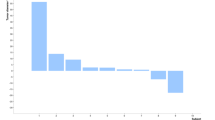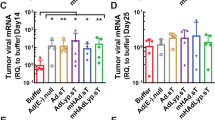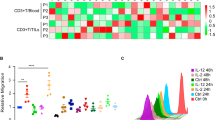Abstract
Cancer gene therapy by adenovirus vectors (Advs) for metastatic cancer is limited because systemic administration of Adv produces low therapeutic effect and severe side effects. In this study, we generated a dual cancer-specific targeting vector system by using PEGylation and the telomere reverse transcriptase (TERT) promoter and attempted to treat experimental metastases through systemic administration of the vectors. We first optimized the molecular size of PEG and modification ratios used to create PEG-Ads. Systemic administration of PEG-Ad with 20-kDa PEG at a 45% modification ratio (PEG[20K/45%]-Ad) resulted in higher tumor-selective transgene expression than unmodified Adv. Next, we examined the effectiveness against metastases and side effects of a TERT promoter-driven PEG[20K/45%]-Ad containing the herpes simplex virus thymidine kinase (HSVtk) gene (PEG-Ad-TERT/HSVtk). Systemic administration of PEG-Ad-TERT/HSVtk showed superior antitumor effects against metastases with negligible side effects. A cytomegalovirus (CMV) promoter-driven PEG[20K/45%]-Ad also produced antimetastatic effects, but these were accompanied by side effects. Combining PEG-Ad-TERT/HSVtk with etoposide or 5-fluorouracil enhanced the therapeutic effects with negligible side effects. These results suggest that modification with 20-kDa PEG at a 45% modification ratio is the optimal condition for PEGylation of Adv, and PEG-Ad-TERT/HSVtk is a prototype Adv for systemic cancer gene therapy against metastases.
This is a preview of subscription content, access via your institution
Access options
Subscribe to this journal
Receive 12 print issues and online access
$259.00 per year
only $21.58 per issue
Buy this article
- Purchase on Springer Link
- Instant access to full article PDF
Prices may be subject to local taxes which are calculated during checkout






Similar content being viewed by others
References
Mizuguchi H, Hayakawa T . Targeted adenovirus vectors. Hum Gene Ther 2004; 15: 1034–1044.
Yang ZR, Wang HF, Zhao J, Peng YY, Wang J, Guinn BA et al. Recent developments in the use of adenoviruses and immunotoxins in cancer gene therapy. Cancer Gene Ther 2007; 14: 599–615.
Eto Y, Yoshioka Y, Mukai Y, Okada N, Nakagawa S . Development of PEGylated adenovirus vector with targeting ligand. Int J Pharm 2008; 354: 3–8.
Horowitz J . Adenovirus-mediated p53 gene therapy: overview of preclinical studies and potential clinical applications. Curr Opin Mol Ther 1999; 1: 500–509.
Kim S, Peng Z, Kaneda Y . Current status of gene therapy in Asia. Mol Ther 2008; 16: 237–243.
Koizumi N, Yamaguchi T, Kawabata K, Sakurai F, Sasaki T, Watanabe Y et al. Fiber-modified adenovirus vectors decrease liver toxicity through reduced IL-6 production. J Immunol 2007; 178: 1767–1773.
Yoshioka Y, Tsutsumi Y, Nakagawa S, Mayumi T . Recent progress on tumor missile therapy and tumor vascular targeting therapy as a new approach. Curr Vasc Pharmacol 2004; 2: 259–270.
Ryan SM, Mantovani G, Wang X, Haddleton DM, Brayden DJ . Advances in PEGylation of important biotech molecules: delivery aspects. Expert Opin Drug Deliv 2008; 5: 371–383.
Iyer AK, Khaled G, Fang J, Maeda H . Exploiting the enhanced permeability and retention effect for tumor targeting. Drug Discov Today 2006; 11: 812–818.
Skinner SA, Tutton PJ, O'Brien PE . Microvascular architecture of experimental colon tumors in the rat. Cancer Res 1990; 50: 2411–2417.
Gao JQ, Eto Y, Yoshioka Y, Sekiguchi F, Kurachi S, Morishige T et al. Effective tumor targeted gene transfer using PEGylated adenovirus vector via systemic administration. J Control Release 2007; 122: 102–110.
Kim NW, Piatyszek MA, Prowse KR, Harley CB, West MD, Ho PL et al. Specific association of human telomerase activity with immortal cells and cancer. Science 1994; 266: 2011–2015.
Gu J, Fang B . Telomerase promoter-driven cancer gene therapy. Cancer Biol Ther 2003; 2: S64–S70.
Majumdar AS, Hughes DE, Lichtsteiner SP, Wang Z, Lebkowski JS, Vasserot AP . The telomerase reverse transcriptase promoter drives efficacious tumor suicide gene therapy while preventing hepatotoxicity encountered with constitutive promoters. Gene Therapy 2001; 8: 568–578.
Yao X, Yoshioka Y, Eto Y, Morishige T, Okada Y, Mizuguchi H et al. TERT promoter-driven adenovirus vector for cancer gene therapy via systemic injection. Biochem Biophys Res Commun 2007; 362: 419–424.
Sakurai H, Kawabata K, Sakurai F, Nakagawa S, Mizuguchi H . Innate immune response induced by gene delivery vectors. Int J Pharm 2008; 354: 9–15.
Tiberghien P . Use of suicide genes in gene therapy. J Leukoc Biol 1994; 56: 203–209.
Connors TA . The choice of prodrugs for gene directed enzyme prodrug therapy of cancer. Gene Therapy 1995; 2: 702–709.
Kaneda Y, Tsutsumi Y, Yoshioka Y, Kamada H, Yamamoto Y, Kodaira H et al. The use of PVP as a polymeric carrier to improve the plasma half-life of drugs. Biomaterials 2004; 25: 3259–3266.
Wortmann A, Vohringer S, Engler T, Corjon S, Schirmbeck R, Reimann J et al. Fully detargeted polyethylene glycol-coated adenovirus vectors are potent genetic vaccines and escape from pre-existing anti-adenovirus antibodies. Mol Ther 2008; 16: 154–162.
Hofherr SE, Shashkova EV, Weaver EA, Khare R, Barry MA . Modification of adenoviral vectors with polyethylene glycol modulates in vivo tissue tropism and gene expression. Mol Ther 2008; 16: 1276–1282.
Koizumi N, Mizuguchi H, Sakurai F, Yamaguchi T, Watanabe Y, Hayakawa T . Reduction of natural adenovirus tropism to mouse liver by fiber-shaft exchange in combination with both CAR- and alphav integrin-binding ablation. J Virol 2003; 77: 13062–13072.
Shayakhmetov DM, Gaggar A, Ni S, Li ZY, Lieber A . Adenovirus binding to blood factors results in liver cell infection and hepatotoxicity. J Virol 2005; 79: 7478–7491.
Parker AL, Waddington SN, Nicol CG, Shayakhmetov DM, Buckley SM, Denby L et al. Multiple vitamin K-dependent coagulation zymogens promote adenovirus-mediated gene delivery to hepatocytes. Blood 2006; 108: 2554–2561.
Sung MW, Yeh HC, Thung SN, Schwartz ME, Mandeli JP, Chen SH et al. Intratumoral adenovirus-mediated suicide gene transfer for hepatic metastases from colorectal adenocarcinoma: results of a phase I clinical trial. Mol Ther 2001; 4: 182–191.
Sterman DH, Recio A, Vachani A, Sun J, Cheung L, DeLong P et al. Long-term follow-up of patients with malignant pleural mesothelioma receiving high-dose adenovirus herpes simplex thymidine kinase/ganciclovir suicide gene therapy. Clin Cancer Res 2005; 11: 7444–7453.
Greco O, Joiner MC, Doleh A, Powell AD, Hillman GG, Scott SD . Hypoxia- and radiation-activated Cre/loxP ‘molecular switch’ vectors for gene therapy of cancer. Gene Therapy 2006; 13: 206–215.
Mathis JM, Williams BJ, Sibley DA, Carroll JL, Li J, Odaka Y et al. Cancer-specific targeting of an adenovirus-delivered herpes simplex virus thymidine kinase suicide gene using translational control. J Gene Med 2006; 8: 1105–1120.
Maeda H, Sawa T, Konno T . Mechanism of tumor-targeted delivery of macromolecular drugs, including the EPR effect in solid tumor and clinical overview of the prototype polymeric drug SMANCS. J Control Release 2001; 74: 47–61.
Bergelson JM, Cunningham JA, Droguett G, Kurt-Jones EA, Krithivas A, Hong JS et al. Isolation of a common receptor for Coxsackie B viruses and adenoviruses 2 and 5. Science 1997; 275: 1320–1323.
Li Y, Pong RC, Bergelson JM, Hall MC, Sagalowsky AI, Tseng CP et al. Loss of adenoviral receptor expression in human bladder cancer cells: a potential impact on the efficacy of gene therapy. Cancer Res 1999; 59: 325–330.
Mathis JM, Stewart PL, Zhu ZB, Curiel DT . Advanced generation adenoviral virotherapy agents embody enhanced potency based upon CAR-independent tropism. Clin Cancer Res 2006; 12: 2651–2656.
Yamashita M, Ino A, Kawabata K, Sakurai F, Mizuguchi H . Expression of coxsackie and adenovirus receptor reduces the lung metastatic potential of murine tumor cells. Int J Cancer 2007; 121: 1690–1696.
Koizumi N, Mizuguchi H, Hosono T, Ishii-Watabe A, Uchida E, Utoguchi N et al. Efficient gene transfer by fiber-mutant adenoviral vectors containing RGD peptide. Biochim Biophys Acta 2001; 1568: 13–20.
Mok H, Palmer DJ, Ng P, Barry MA . Evaluation of polyethylene glycol modification of first-generation and helper-dependent adenoviral vectors to reduce innate immune responses. Mol Ther 2005; 11: 66–79.
Lehrman S . Virus treatment questioned after gene therapy death. Nature 1999; 401: 517–518.
Marshall E . Gene therapy death prompts review of adenovirus vector. Science 1999; 286: 2244–2245.
Sakurai H, Tashiro K, Kawabata K, Yamaguchi T, Sakurai F, Nakagawa S et al. Adenoviral expression of suppressor of cytokine signaling-1 reduces adenovirus vector-induced innate immune responses. J Immunol 2008; 180: 4931–4938.
Croyle MA, Chirmule N, Zhang Y, Wilson JM . Stealth″ adenoviruses blunt cell-mediated and humoral immune responses against the virus and allow for significant gene expression upon readministration in the lung. J Virol 2001; 75: 4792–4801.
De Geest B, Snoeys J, Van Linthout S, Lievens J, Collen D . Elimination of innate immune responses and liver inflammation by PEGylation of adenoviral vectors and methylprednisolone. Hum Gene Ther 2005; 16: 1439–1451.
Wildner O, Blaese RM, Candotti F . Enzyme prodrug gene therapy: synergistic use of the herpes simplex virus-cellular thymidine kinase/ganciclovir system and thymidylate synthase inhibitors for the treatment of colon cancer. Cancer Res 1999; 59: 5233–5238.
Shieh GS, Shiau AL, Yo YT, Lin PR, Chang CC, Tzai TS et al. Low-dose etoposide enhances telomerase-dependent adenovirus-mediated cytosine deaminase gene therapy through augmentation of adenoviral infection and transgene expression in a syngeneic bladder tumor model. Cancer Res 2006; 66: 9957–9966.
Mader RM, Muller M, Steger GG . Resistance to 5-fluorouracil. Gen Pharmacol 1998; 31: 661–666.
Mizuguchi H, Kay MA . Efficient construction of a recombinant adenovirus vector by an improved in vitro ligation method. Hum Gene Ther 1998; 9: 2577–2583.
Mizuguchi H, Kay MA . A simple method for constructing E1- and E1/E4-deleted recombinant adenoviral vectors. Hum Gene Ther 1999; 10: 2013–2017.
Okada Y, Okada N, Mizuguchi H, Hayakawa T, Nakagawa S, Mayumi T . Transcriptional targeting of RGD fiber-mutant adenovirus vectors can improve the safety of suicide gene therapy for murine melanoma. Cancer Gene Ther 2005; 12: 608–616.
Eto Y, Gao JQ, Sekiguchi F, Kurachi S, Katayama K, Maeda M et al. PEGylated adenovirus vectors containing RGD peptides on the tip of PEG show high transduction efficiency and antibody evasion ability. J Gene Med 2005; 7: 604–612.
Acknowledgements
This study was supported in part by grants from the Ministry of Health, Labor, and Welfare in Japan and by the Research on Health Sciences focusing on Drug Innovation from the Japan Health Sciences Foundation.
Author information
Authors and Affiliations
Corresponding authors
Rights and permissions
About this article
Cite this article
Yao, X., Yoshioka, Y., Morishige, T. et al. Systemic administration of a PEGylated adenovirus vector with a cancer-specific promoter is effective in a mouse model of metastasis. Gene Ther 16, 1395–1404 (2009). https://doi.org/10.1038/gt.2009.95
Received:
Revised:
Accepted:
Published:
Issue Date:
DOI: https://doi.org/10.1038/gt.2009.95
Keywords
This article is cited by
-
Challenges and progress toward tumor-targeted therapy by systemic delivery of polymer-complexed oncolytic adenoviruses
Cancer Gene Therapy (2022)
-
Practical Issues with the Use of Stem Cells for Cancer Gene Therapy
Stem Cell Reviews and Reports (2015)
-
Tumor Vascular Targeted Delivery of Polymer-conjugated Adenovirus Vector for Cancer Gene Therapy
Molecular Therapy (2011)



